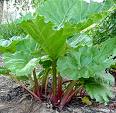 We have it with custard, in pies and as a crumble just like any fruit dessert, but is it a fruit?
We have it with custard, in pies and as a crumble just like any fruit dessert, but is it a fruit?
No, strictly speaking the bright red or pink stems are the sweetish stalks of the rhubarb vegetable.
The word rhubarb is thought to come from “Rhu”, a local name for the river Volga in Russia where it is grown in abundance. In any event the plant originated from Russia and China where it was used extensively for medicinal purposes. The Chinese rhubarb is still used for gastroenteritis ailments.
The plant we grow in our gardens is a hybrid developed in Europe in the 16th century and was an ornamental garden plant long before it became popular for culinary purposes.
The process of forcing rhubarb is due to a chance discovery by the head gardener of the Chelsea Physic Garden in 1815. He noticed that when the stems were covered in soil they developed a pinkish hue. Presumably he thought these pink stalks looked appetizing and found that when cooked they were quite tasty. Commercial growers began lifting rhubarb and replanting it indoors in long low wooden sheds which became a feature of the landscape. Young stems of rhubarb are still picked in these sheds by candlelight to prevent losing the pink colour. It is said that you can even hear the shoots growing.
 The area around Wakefield, Bradford and Leeds became known as the rhubarb triangle in the nineteenth and early twentieth centuries because of the ideal growing conditions and at its height there were over 200 producers. During the second world war with imported fruit virtually unobtainable, the Government kept the price of rhubarb low to make up for the loss of essential vitamins. After the war with exotic fruits back in the shops, rhubarb became less popular and the number of growers in the rhubarb triangle fell to a mere dozen.
The area around Wakefield, Bradford and Leeds became known as the rhubarb triangle in the nineteenth and early twentieth centuries because of the ideal growing conditions and at its height there were over 200 producers. During the second world war with imported fruit virtually unobtainable, the Government kept the price of rhubarb low to make up for the loss of essential vitamins. After the war with exotic fruits back in the shops, rhubarb became less popular and the number of growers in the rhubarb triangle fell to a mere dozen.
PETER ARMSTRONG
 We have it with custard, in pies and as a crumble just like any fruit dessert, but is it a fruit?
We have it with custard, in pies and as a crumble just like any fruit dessert, but is it a fruit?  The area around
The area around